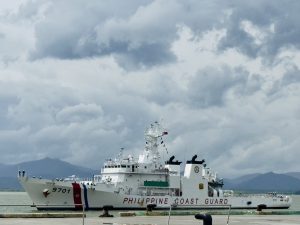The Philippine Coast Guard (PCG) says that it will continue to deploy vessels at Sabina Shoal in the South China Sea, after a ship ended a five-month deployment to the disputed reef.
Speaking at a press conference this morning, a day after the BRP Teresa Magbanua returned to port on Palawan island, PCG spokesperson Jay Tarriela vowed that the PCG “will continue to deploy vessels in Escoda Shoal.” (This is Manila’s official name for the feature, one of nine that it controls in the Spratly Islands.)
“We will sustain presence over these waters,” Tarriela said, according to a report by Reuters. “Regardless of what size of vessel, regardless of how many vessels, the main objective and the commitment of the (PCG) commandant… is to make sure that at any one time, there will be a coast guard presence in the shoal.”
The Teresa Magbanua, the PCG’s 2,200-ton flagship, was deployed to Sabina Shoal in April to monitor the constant presence of the China Coast Guard in the region and to investigate suspected land reclamation activities in the area. Tarriela said at the time that there had been “small-scale reclamation” of Sabina Shoal, and that China was “the most probable actor.”
The vessel then left unexpectedly yesterday for Puerto Princesa on Palawan island. In a statement, the PCG said that the crew’s “steadfast presence has played a crucial role in countering illegal activities that threaten our marine environment and thwarting attempts by other state actors to engage in surreptitious reclamation in the area.” The National Maritime Council added that a replacement vessel was on the way to the shoal, which lies around 140 kilometers to the west of Palawan.
Sabina Shoal has been the subject of recent frictions between the PCG and China Coast Guard, as China has denounced what it viewed as the “illegal grounding” of the BRP Teresa Magbanua at Sabina Shoal and deployed a large number of ships there to monitor its activities.
These incidents have all involved the CCG’s ramming of Philippine vessels and its use of high-pressure water cannons. In one incident on August 19, two PCG vessels were damaged in a collision with a China Coast Guard (CCG) ship. Another on August 25 involved a collision between the CCG and a ship from the Philippine Bureau Fisheries and Aquatic Resources. The tensions have worsened especially since late June, when Beijing and Manila agreed to deescalate tensions around Second Thomas Shoal after a violent melee between Philippine and Chinese personnel on June 17.
The departure of the Teresa Magbanua raised immediate questions about whether the Philippines had been forced to back down in the face of China’s growing pressure. Some observers drew comparisons with Scarborough Shoal, which ended up under Chinese control after a protracted stand-off between the Philippines and China in 2012. Some have also asked why the ship was not relieved earlier, in order to ensure a constant Philippine presence at Sabina Shoal.
Tarriela said yesterday that this parallel with the Scarborough Shoal situation had no merit, not least due to the size of Sabina Shoal, which extends over 137 square kilometers. This made it hard for China to prevent the Philippines from patrolling the area, he said. “We are just repositioning our vessel,” Tarriela said, The Inquirer reported. “It doesn’t mean that coast guard vessels will no longer be deployed there.”
Philippine authorities offered a number of explanations for the withdrawal of the Teresa Magbanua, including bad weather, low supplies, and damage sustained during a collision with a Chinese vessel. The PCG also announced that four crew members were sick and needed medical treatment. According to subsequent reports, the crew members had become severely dehydrated due to a Chinese blockade of the Teresa Magbanua while it was stationed at Sabina Shoal.
This suggests that the withdrawal was not planned, and may have been undertaken at the last minute, without the time necessary to deploy another ship to the disputed feature. This in turn suggests that the Chinese approach of besieging and waiting out the Philippine vessel was successful, at least in this instance – a conclusion with worrying implications for Manila’s ability to maintain control indefinitely of its nine islands and features in the Spratly Islands.
It also raises the possibility of some degree of U.S. involvement in the maritime disputes between the Philippines and China. While U.S. officials say they are ready to “do what is necessary” to aid the Philippines in the South China Sea, Manila has been more cautious about pulling that trigger. In July, Gen. Romeo Brawner, the chief of staff of the Armed Forces of the Philippines, told reporters that Manila preferred to conduct unilateral operations. But he added that this could change if the country finds itself without viable alternatives.
“When our troops are already hungry, they don’t have any supplies anymore because our resupply mission have been blocked and they are on the verge of dying, then that’s the time we are going to seek the help of the United States,” Brawner said.
































